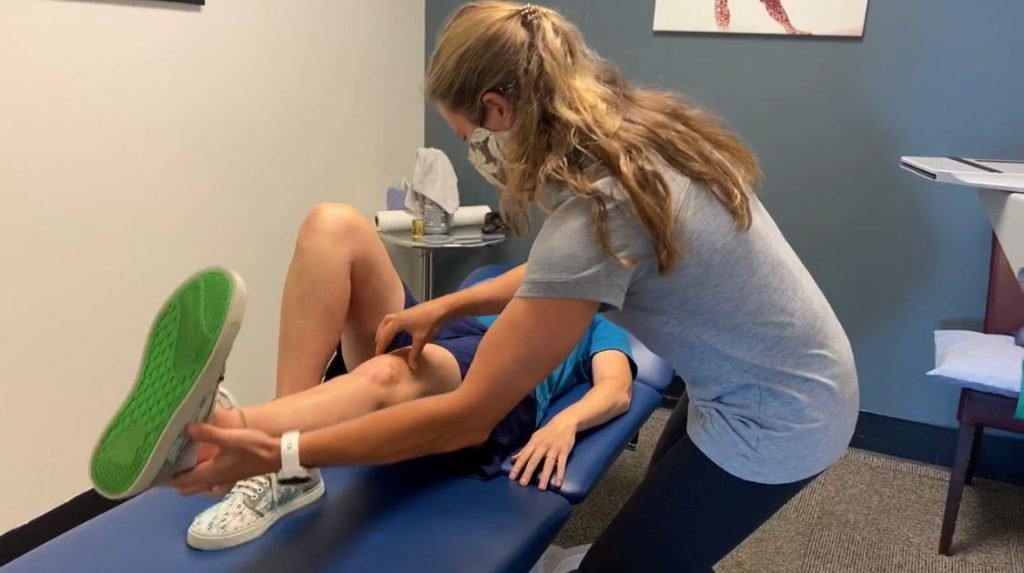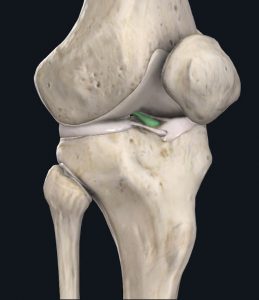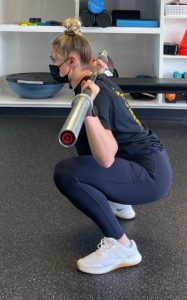
ACL rehab can be challenging. You’ll be working toward recovery for months.
But, with physical therapy and enough dedication, you can emerge stronger. Not only will you heal, but you will also drastically improve your movement mechanics to prevent future injury.
For best outcomes, you have to understand your injury. Keep reading to learn about the ACL, general protocol/timelines, and what to expect during your rehabilitation.
What is an ACL?
The ACL is the anterior cruciate ligament that crosses diagonally through the inside of the knee joint, giving your knee stability.
- ACL (highlighted) | Image courtesy of Complete Anatomy
You have many ligaments in the knee, but the ACL is one of the most important for stability, especially if you are an athlete or active person. It is important with impact activity, cutting and changing direction, and making sudden stops so that your knee joint maintains alignment.
Who is at Risk for ACL Tears?
You are more likely to tear your ACL if you have:
- weakness in your thigh or hip muscles
- poor landing mechanics
- torn an ACL before
A previous ACL tear is the most common predisposing factor to having a second tear, so thorough rehabilitation is crucial to prevent re-injury. We often try to get back out to our hobbies and sports so quickly that it may be too much for the knee to physically handle, which can cause another tear.
It is very common to also tear the meniscus in the same injury as the ACL tear.
Treatment for ACL Tears
Most ACL tears undergo surgery to reconstruct the ligament rather than repairing the tear.
The surgeon may choose between two common sources:
- An allograft, which uses a cadaver graft that is not part of your own body. This means that there is only one surgery site.
- An autograft, which uses part of your own body tissue from another area. The surgeon commonly uses part of your patellar tendon, quadriceps tendon, or hamstring tendon.
There are pros and cons to all sources, and your surgeon will use their expertise and the age of the patient to decide which is the most appropriate.
If you also tore your meniscus in the same injury, your surgeon may choose to repair it or shave it down during surgery. The surgeon’s decision to repair, shave, or leave the meniscus depends on its size and location.
Interestingly, there is new research that shows ACL tears may even heal on their own. Surgery may not be your only option! However, proper rehab is still crucial for recovery regardless.
ACL Prehabilitation
Most patients with ACL tears opt for the surgery. Prior to surgery, the doctor may or may not have you come to physical therapy.
If you do come to therapy, a physical therapist (PT) will assess your knee range of motion and leg strength to determine our plan to get the best possible outcomes for your surgery.
Priorities of physical therapy before surgery:
- achieving full range of motion
- reduce any limping or movement compensation
- improve thigh strength, specifically quadriceps (quad) activation
The PT will show you different ways of stretching the knee and improving your quad activation so that you can continue to perform after the operation.
You’ll become familiar with the expectations after surgery, which should boost your confidence.
ACL Rehab: What to Expect
The fun part!
You will likely see your PT during the first week after surgery, but this depends on the surgeon’s recommendation. Here’s what you can expect.
Bracing and Crutches
Most ACL surgeries will likely require crutches and a knee brace after the operation. The brace may be locked or unlocked depending on what the surgeon repaired inside of your knee.
Make sure you comply with the surgeon’s protocol. (S)he may specify:
- how much weight to put on your leg
- if your brace is meant to stay locked or unlocked
It’s important to know your protocol so you don’t re-injure your knee or delay healing. If you’re not sure about your protocol, don’t assume. Ask your surgeon or your PT.
If your surgeon decides to repair the meniscus during the ACL surgery, you may need to use crutches and not put weight on your leg for about 4 to 6 weeks. You may also have bending restrictions to protect the meniscus while it heals.
If the surgeon shaves away and cleans out the torn part (a meniscectomy), your time on crutches may be shorter and you may be able to put weight through your leg sooner than if the meniscus is repaired.
If there is no meniscus involvement, your time on crutches also may be shorter than if the meniscus is operated on.
Every knee is different, so listen to your doctor’s instructions.
Swelling Control and Mobility
Right after surgery, it is most important to reduce pain and swelling. Ice and elevation is the first step.
You want to spend time with the knee fully straight to achieve full extension early. This motion is most important at the early stages of rehab to normalize your walking pattern later. Avoid using a pillow under the knee when relaxing or icing to prevent loss of knee extension, even if it is more comfortable.
Pain relief techniques include:
- icing 15 minutes every 1-2 hours
- elevating the leg higher than your heart by lying on your back with your leg propped up
- pain medication or anti-inflammatories prescribed or instructed by the doctor
- gentle movement of the knee to prevent it from getting stiff
Remember: Follow your protocol! It can help you avoid spikes in swelling and pain which can delay your healing.
Weight-Bearing and Walking
Once protocol allows you to place weight through your leg, your physical therapist can assist you with a gradual introduction to full weight-bearing so that you do not develop a limp or compensations while walking.
You’ll start with crutches and slowly wean off of them by removing one at a time over the course of a few weeks, depending on your knee’s status.
It is important to have the doctor or therapist assess whether your knee mobility, swelling, and strength have improved enough to walk without your crutches.
A General Protocol/Timeline for ACL Rehab
The first month focuses primarily on protecting the surgery during mobility and foundational strengthening exercises. It is critical that you follow your protocol and stay diligent performing your exercises as prescribed. The first month determines your trajectory for the following months.
Your PT may decide that blood flow restriction training is appropriate, especially if you have been given weight-bearing restrictions by your surgeon.
The next 2-3 months of physical therapy prioritize:
- normalizing your walking pattern
- reaching full knee range of motion
- improving your leg muscle strength
Studies have even shown that squatting and lunging puts less strain on the ACL than walking, so don’t worry about performing these lower body exercises under guidance from your therapist.
In fact, your PT will assign a strengthening program outside the physical therapy clinic to more effectively address your deficits. You are expected to comply with your program so that you progress well towards your goals, including return to sport.
Once you are able to achieve full motion and meet the standards for strength set by your PT and surgeon, you will begin impact activity.
Impact activity, including an introduction to jogging and light jumping, typically starts around 4 months. This may vary, though. It’s important to meet all the strength and mobility requirements first, showing that the knee and ACL are ready for progression.
Between 4-10 months, you are focusing on building the strength needed for return to sport. If your sport requires agility and sprinting, it’s not enough to stop at jogging. You and your PT will progress impact activity, working on:
- Double-limb landing
- Single-limb landing
- Cutting mechanics
- Double-tasking and attention-splitting exercises
- Any other sport-specific activities
Mental preparedness and confidence are also important to address. Your therapist and doctor are trained to assess both physical and psychological readiness to return to full activity. If you’re not mentally prepared, you may compensate for your injury and place yourself at risk.
Full return to sport may not happen until around 10-12 months after the surgery.
Remember that the most common predictor of an ACL tear is a previous tear, and the risk increases if you return too soon or when the knee is not properly prepared.
For every month you wait to return to sport, your risk of re-injury is reduced by 51% (up to 9 months post op).
Having full range of motion of the knee and not having pain is not enough alone to return to your usual activities.
Returning to Sport after ACL Rehab
To reduce the risk of re-injury when returning to your activities, your physical therapist will set very clear goals and milestones specific to your needs. Some goals may require return-to-sport testing. There are many specific quadriceps and leg strength measures, landing mechanics, and balance and jumping tests that are used to assess your readiness to return to your usual activities.
Some of these tests could include:
- quad strength testing
- single leg hopping and landing
- single leg squatting
- reaction time testing
Tests ensure that there are no compensations remaining on the injured side. Not only do we want to make sure that the leg is strong and ready, but also that you’re confident in it. You want to avoid favoring the uninjured side.
Based on test results, your therapist can help prescribe a return to running or playing protocol that will safely get you back to doing what you love.
It is always important to wait until cleared by the surgeon and/or physical therapist to return to sports, following specific guidelines that your physical therapist will clarify.
Some surgeons require you to wear an ACL brace when returning to sport, especially if your sport involves heavy contact or cutting. This is because full knee strength (equal to the uninjured side) may take up to one year to fully return.
That means, even after you graduate from physical therapy, you must continue to perform strengthening exercises for about one year before resuming your pre-injury training schedule!
Looking for 1-on-1 Physical Therapy?
JACO Rehab can help you get back to your regularly scheduled programming! Work with our therapists 1-on-1 for over 50 minutes every session.
Call us at 808-381-8947 to learn how you can schedule a prehabilitation or rehabilitation appointment at one of our four locations on Oahu: Honolulu, Waikele, Mililani, and Kapolei.
Written by Rebecca Enderica, DPT

